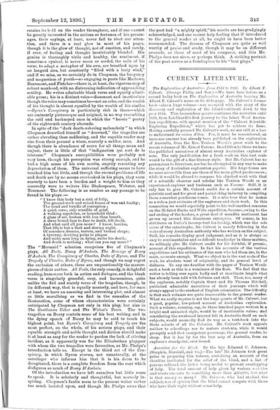CURRENT LITERATURE.
The Exploration of Australia : from 1814 to 1896. By Albert F. Calvert. (George Philip and Son.)—We have here before us a second bulky book on The Exploration of Australia bearing Mr. Albert F. Calvert's name on its title-page. Mr. Calvert's former book—also a huge volume—was occupied with the story of the discovery and exploration of the island-continent down to the year 1844. This tremendous quarto continues the narrative until 1890, from Leichhardt's first journey to the latest West Austra- lian expeditions, with special mention of the " Calvert Scientific Exploring Expedition," which has yet to achieve its fame. Having carefully perused Mr. Calvert's work, we are still at a loss to understand its raison d'être. For, it must be remembered, an immense amount has already been published on the exploration of Australia, from the Rev. Tenison Woods's great work to the recent volumes of Mr. Ernest Favenc. In addition to these we have the published narratives of almost every Australian explorer of note. The only justification for a fresh work on this vast scale would be the gift of a fine literary style. But Mr. Calvert has no pretensions to literature, nor has he attempted in any way to make the story of Australian exploration popular. His huge tomes are no more accessible than are those of his more gifted predecessors ; while it would be absurd to compare his slipshod work with that of a scientific observer and scholar like Tenison Woods or an experienced explorer and bushman such as Favenc. Still, it is only fair to give Mr. Calvert credit for a certain amount of patriotic zeal and for great and painstaking industry in compiling these somewhat ponderous tomes. It is also true that he makes as a rule a just estimate of the explorers and their work. In this connection we would especially point to his well-merited censures on the ill-fated Burke and Wills expedition, because, owing to the sad ending of the leaders, a great deal of maudlin sentiment has grown up around this disastrous enterprise. Of course, in his strictures on Burke's incompetent leadership, which was the sole cause of the catastrophe, Mr. Calvert is merely following in the wake of every Australian authority who has ivritten on the shbject. Still, his remarks display good judgment, and as it is alwhys so easy to sentimentalise and so difficult to adjudge in thesesmatttirs, we willingly give Mr. Calvert credit for his faithful; if prosaic, account of this expedition. In fact his accounts of the various expeditions and his estimates of the men who led them are, in.the main, accurate enough. What we object to is the vast scale of the work, its absolute want of originality, and its general level of dullness. To any one familiar with the pages of Tenison Woods such a book as this is a weariness of the flesh. We feel that the writer is telling over again badly and at inordinate length what has already been told with fullness and skill. Then, too, many of the explorers, notably Captain Sturt and Sir Thomas Mitchell, published admirable narratives of their journeys] which will always appeal to the student of English colonisation. The difficulty is that such volumes are quite inaccessible to the general reader. What we really require is not the huge quarto of Mr. Calvert, but a good, popular, low-priced account of Australian exploration. Such a volume, running, say, to three hundred pages written in a bright and animated style, would be of inestimable values And considering the awakened interest felt in Australia itself on such subjects, would assuredly find its way as a text-book into the State schools of all the Colonies. Mr. Calvert's work appeals neither to schoolboys nor to mature students, while it would promptly send that omnipotent personage, the general reader, to sleep. But it has by far the best map of Australia, from an explorer's standpoint, ever issued.


































 Previous page
Previous page